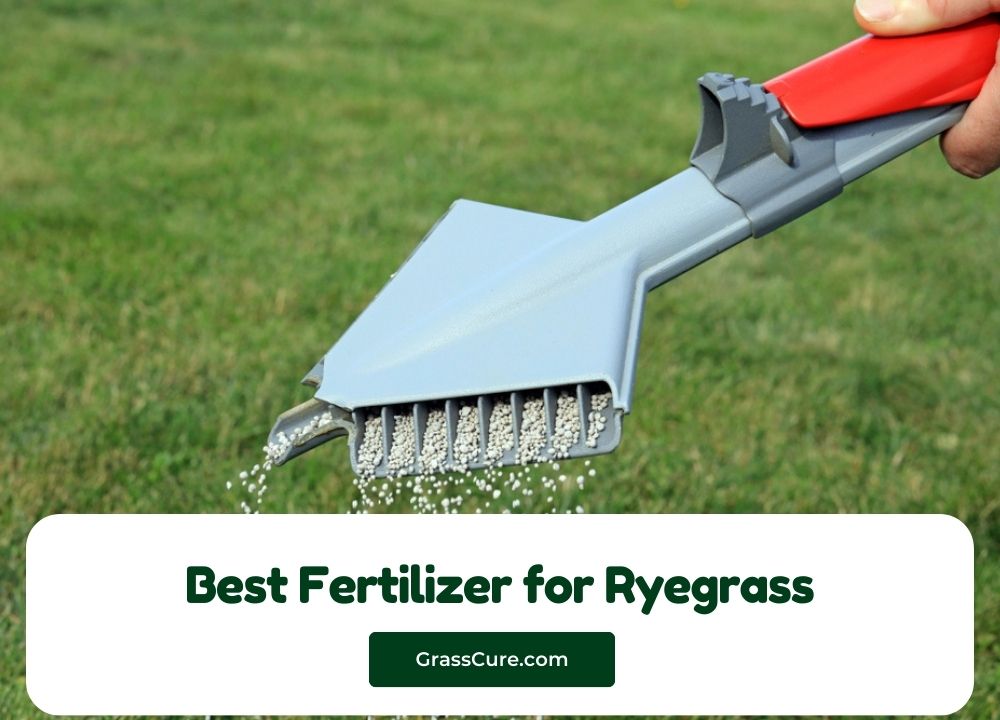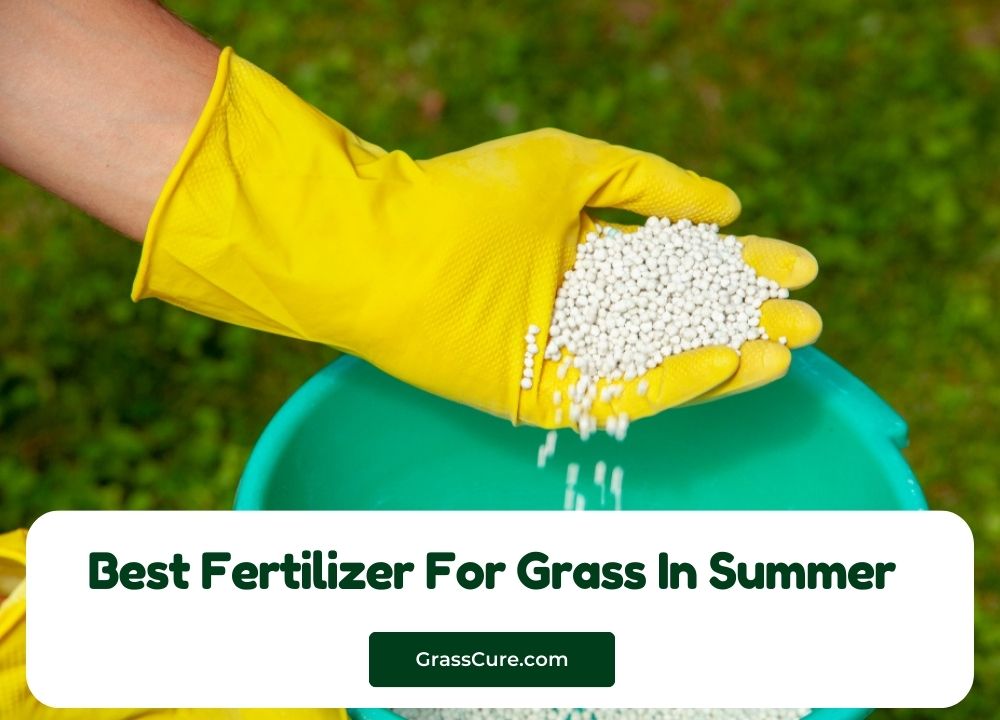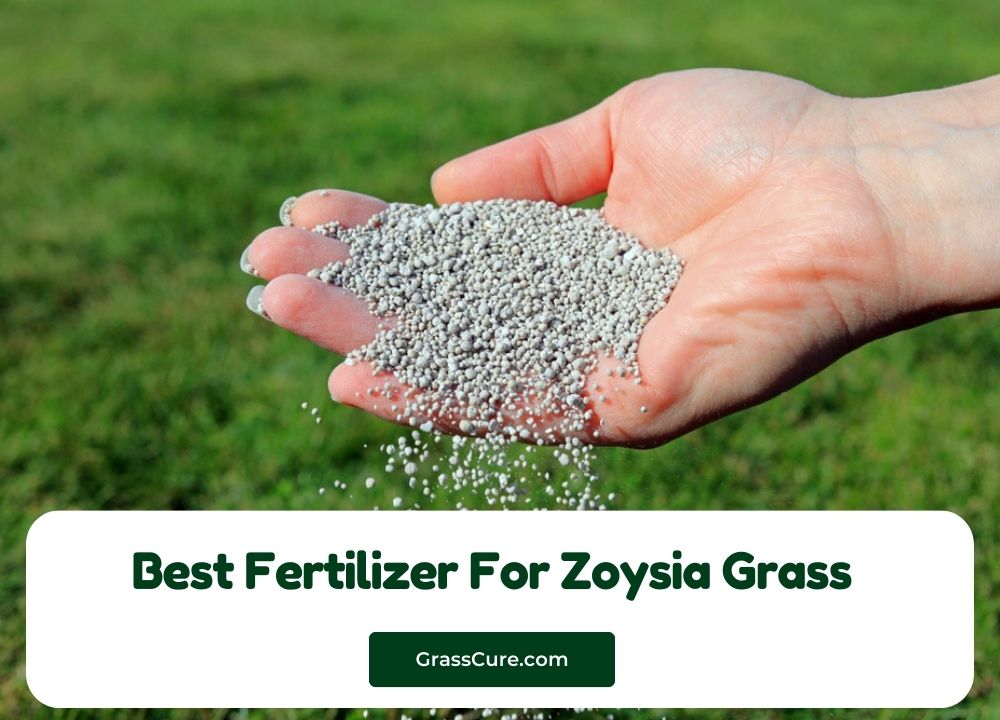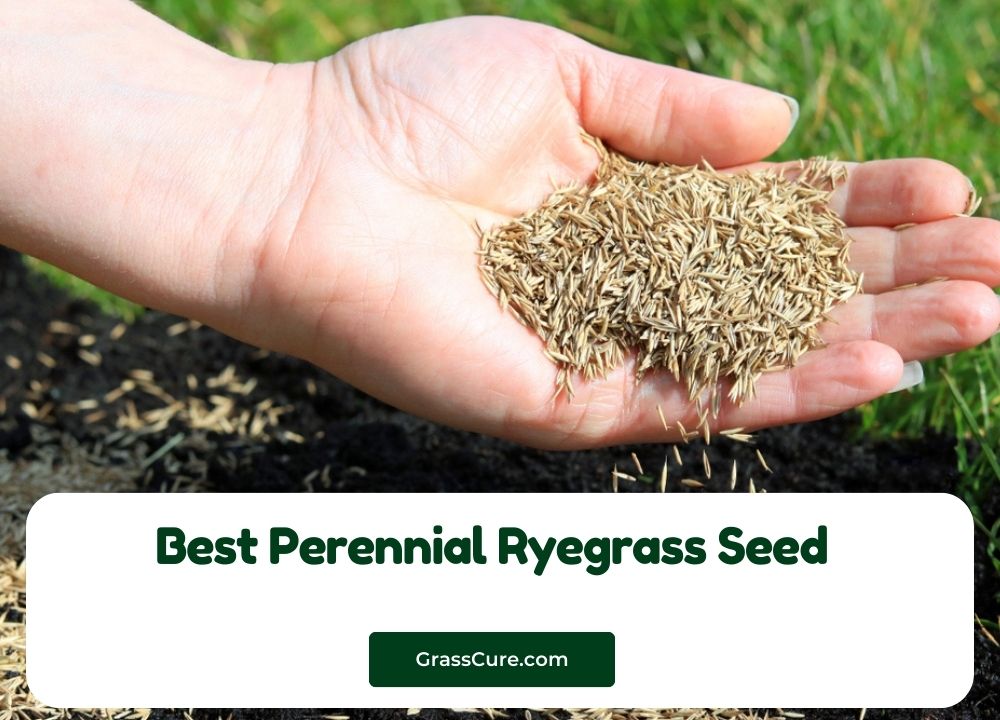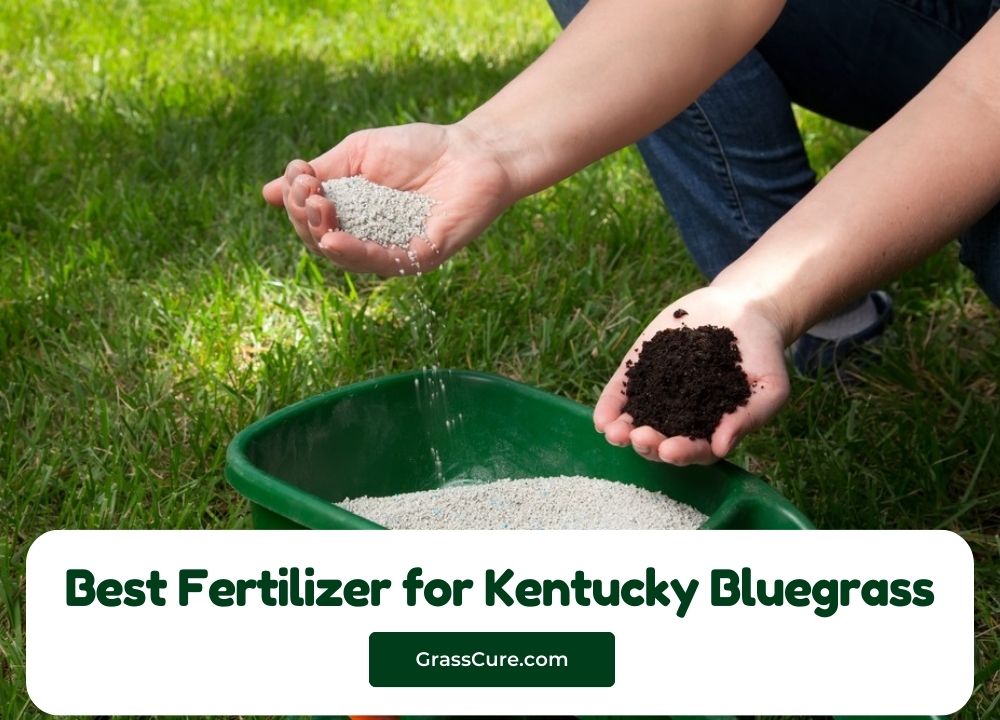Ryegrass is a popular choice for lawns, athletic fields, and erosion control due to its fast germination and lush green appearance. Its versatility makes it suitable for a variety of climates and soil types, providing an ideal foundation for healthy turf. However, achieving optimal growth and maintaining its vibrant color requires proper fertilization. Fertilizers play a crucial role in supplying essential nutrients that promote vigorous growth, disease resistance, and overall lawn health. This article aims to explore the best fertilizers for ryegrass, reviewing their effectiveness, application methods, and specific benefits to help gardeners and landscapers make informed decisions for thriving ryegrass lawns.
Contents
Understanding Ryegrass
Ryegrass, a member of the Poaceae family, is widely cultivated for its aesthetic and functional benefits. There are two primary types of ryegrass: perennial ryegrass and annual ryegrass.
- Types of Ryegrass
- Perennial Ryegrass: Known for its fine texture and vibrant green color, perennial ryegrass is ideal for permanent lawns and is often used in blends for its rapid establishment. It thrives in cool-season areas and is favored for its ability to recover quickly from wear and tear.
- Annual Ryegrass: Often used as a cover crop, annual ryegrass is quick to germinate and establishes rapidly, making it effective for preventing soil erosion and improving soil health. However, it is not intended for permanent lawns as it dies off in warmer temperatures.
- Growth Requirements Ryegrass prefers well-draining soils and can tolerate a range of pH levels, though it thrives in slightly acidic to neutral conditions (pH 6.0 to 7.0). It requires full sun to partial shade and adequate moisture for optimal growth.
- Nutritional Needs Ryegrass has specific nutritional requirements that must be met for robust growth:
- Key Nutrients:
- Nitrogen (N): Crucial for vegetative growth and green color; helps in leaf development and overall plant vigor.
- Phosphorus (P): Important for root development and energy transfer, especially during establishment.
- Potassium (K): Enhances drought resistance, disease tolerance, and overall stress management.
- Secondary Nutrients and Micronutrients: Ryegrass also benefits from secondary nutrients like calcium, magnesium, and sulfur, as well as micronutrients such as iron and manganese, which support various physiological functions.
- Key Nutrients:
Fertilizer Types
Choosing the right fertilizer for ryegrass involves understanding the different types available and their specific benefits. Fertilizers can be broadly categorized into synthetic and organic options, with additional distinctions based on their release rates.
Synthetic Fertilizers
- Overview and Benefits: Synthetic fertilizers are chemically manufactured and are designed to provide precise nutrient ratios. They are often more concentrated than organic fertilizers, allowing for smaller application volumes and immediate availability of nutrients.
- Common Brands and Formulations: Popular synthetic fertilizers for ryegrass include:
- Urea: High in nitrogen, ideal for promoting rapid growth.
- Triple Super Phosphate: Rich in phosphorus, useful during the establishment phase.
- Potassium Nitrate: Supplies both nitrogen and potassium, beneficial for overall health and stress resistance.
Organic Fertilizers
- Overview and Benefits: Organic fertilizers are derived from natural sources such as plant or animal matter. They not only provide essential nutrients but also improve soil structure and health over time. These fertilizers release nutrients more slowly, promoting gradual uptake by plants.
- Types of Organic Fertilizers Suitable for Ryegrass:
- Compost: Enhances soil fertility and structure while providing a balanced nutrient supply.
- Fish Emulsion: Rich in nitrogen and trace minerals, it promotes lush growth and is often used in liquid form.
- Bone Meal: High in phosphorus, it supports root development and is particularly beneficial during planting.
Slow-Release vs. Fast-Release Fertilizers
- Differences and Impacts on Ryegrass Growth:
- Slow-Release Fertilizers: These fertilizers release nutrients gradually over an extended period, reducing the risk of nutrient leaching and providing a consistent supply of nutrients. They are ideal for long-term maintenance of ryegrass.
- Fast-Release Fertilizers: These offer immediate nutrient availability, making them suitable for quick fixes or during peak growing periods. However, they require more frequent applications to maintain nutrient levels.
Best Fertilizers for Ryegrass Review:
1. Organic Milorganite Fertilizer
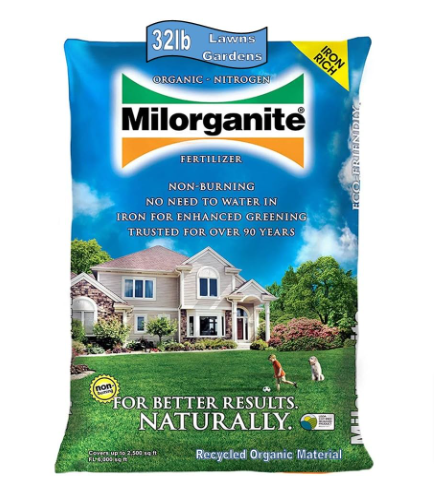
Milorganite is a popular organic nitrogen fertilizer made from recycled municipal wastewater. It is known for its unique production process, which involves treating sewage sludge to create a safe and effective fertilizer. Milorganite is particularly favored for its slow-release nitrogen, making it an excellent choice for various lawn and garden applications, including ryegrass.
Key Features
- Nutrient Composition: Milorganite has an N-P-K ratio of 6-2-0, meaning it contains 6% nitrogen, 2% phosphorus, and no potassium. The nitrogen is derived from organic sources, providing a steady supply of nutrients that promotes healthy growth without the risk of burning plants.
- Slow-Release Formula: Milorganite releases nitrogen slowly over time, which means it nourishes plants gradually. This feature is especially beneficial for ryegrass, as it supports consistent growth and reduces the need for frequent applications.
- Organic Certification: Being derived from recycled organic material, Milorganite is considered an organic fertilizer, making it suitable for environmentally conscious gardeners.
Benefits for Ryegrass
- Promotes Lush Green Growth: The high nitrogen content encourages vigorous leaf and stem development, resulting in a lush, green lawn.
- Improves Soil Health: Milorganite enhances soil structure and microbial activity, leading to improved water retention and nutrient availability.
- Reduced Leaching: The slow-release nature minimizes nutrient leaching into water systems, making it an environmentally friendly option.
Application Guidelines
- When to Apply: Milorganite can be applied in early spring or fall, during the active growth periods of ryegrass. It’s also beneficial after overseeding to support new growth.
- How to Apply: Spread Milorganite evenly over the lawn using a broadcast spreader. It’s recommended to apply 1 to 2 pounds per 100 square feet, depending on the lawn’s nutritional needs and soil test results.
Considerations
- Odor: Some users report an odor when applying Milorganite, particularly when first applied. However, this typically dissipates after watering and with time.
- Phosphorus Content: With only 2% phosphorus, it may not be suitable for soils that are deficient in this nutrient. Soil testing is advisable to determine specific nutrient needs.
Milorganite Recycled Lawn and Garden Nitrogen Fertilizer is a reliable and eco-friendly option for promoting healthy ryegrass growth. Its slow-release nitrogen, coupled with its ability to improve soil health, makes it a top choice for gardeners looking to establish and maintain a vibrant, resilient lawn.
2. Scotts Turf Builder Triple Action
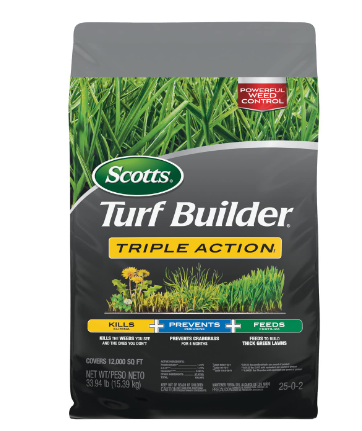
Scotts Turf Builder Triple Action1 is a versatile lawn care product designed to provide a comprehensive solution for maintaining healthy grass while controlling weeds. This all-in-one formula combines weed control, weed prevention, and fertilization, making it an excellent choice for those seeking to improve the overall health and appearance of their ryegrass and other lawns.
Key Features
- N-P-K Ratio: This product typically has an N-P-K ratio of 28-0-3, providing a high nitrogen content to promote lush growth and vibrant color while also offering potassium for overall plant health.
- Combination Formula: The unique formulation serves three purposes:
- Weed Control: It effectively kills existing weeds, including dandelions and clover, without harming the grass.
- Weed Prevention: The product contains pre-emergent herbicides that help prevent new weeds from germinating.
- Fertilization: Provides essential nutrients to promote a robust, healthy lawn.
Benefits for Ryegrass
- Promotes Strong Growth: The high nitrogen content supports vigorous growth, ensuring that ryegrass develops a lush, green appearance.
- Weed Management: By targeting both existing and potential weed problems, it helps maintain a clean and healthy lawn, reducing competition for nutrients and moisture.
- Easy Application: The granular form is easy to apply using a broadcast spreader, covering up to 12,000 square feet with a single 33.94 lbs. bag.
Application Guidelines
- When to Apply: Scotts Turf Builder Triple Action1 is best applied during the active growing season (spring or fall) when weeds are present. It’s crucial to follow application timing based on local weed growth patterns for maximum effectiveness.
- How to Apply: Use a broadcast spreader for even distribution. Ensure the lawn is moist before application for better adherence to weeds. Water lightly after application to activate the fertilizer and herbicide components.
Considerations
- Temperature Sensitivity: Avoid applying during extreme heat or drought conditions, as this can stress the grass and limit its recovery.
- Impact on Desired Plants: Be cautious if planting new grass or overseeding, as the pre-emergent herbicide can hinder the germination of grass seeds. It’s best to wait a few months after application to seed new areas.
- Reapplication Schedule: Depending on the product’s label instructions, reapplication may be necessary to maintain weed control and nutrient levels, especially during peak growing seasons.
Scotts Turf Builder Triple Action1 is an effective solution for maintaining a healthy ryegrass lawn while managing weed growth. Its combination of fertilization and weed control features makes it a convenient choice for homeowners seeking to simplify their lawn care routine. With proper application, this product can help achieve a vibrant, weed-free lawn that stands out in any landscape.
3. Advanced 16-4-8 Balanced NPK – Lawn Food Quality Liquid Fertilizer
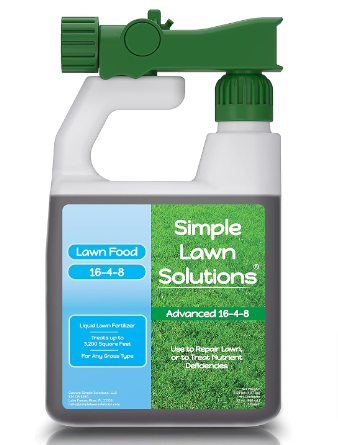
Advanced 16-4-8 Balanced NPK is a high-quality liquid fertilizer designed to support lawn health during the spring and summer months. Formulated by Simple Lawn Solutions, this concentrated spray is suitable for any grass type, including ryegrass, making it an excellent choice for homeowners looking to enhance their lawn’s growth and appearance.
Key Features
- N-P-K Ratio: This fertilizer features a balanced N-P-K ratio of 16-4-8, providing a significant amount of nitrogen (16%) to promote vigorous growth, moderate phosphorus (4%) for root development, and ample potassium (8%) to enhance overall plant health and stress tolerance.
- Liquid Concentrate: The 32-ounce concentrated formula allows for easy dilution with water, enabling quick application through a sprayer or watering can.
- Versatility: Suitable for all grass types, this fertilizer can be used on cool-season and warm-season grasses, making it a versatile option for various lawn care needs.
Benefits for Ryegrass
- Rapid Nutrient Uptake: The liquid form ensures quick absorption of nutrients, leading to immediate improvements in grass color and growth, especially important during the active growing season.
- Promotes Healthy Growth: The higher nitrogen content encourages lush green growth, while potassium aids in overall plant health, improving resilience against environmental stresses like drought or disease.
- Enhanced Soil Quality: The balanced nutrient profile not only supports grass health but also contributes to improved soil structure and fertility over time.
Application Guidelines
- When to Apply: Ideal for use in spring and summer when grass is actively growing. Applications can be made every 4-6 weeks during the growing season for optimal results.
- How to Apply: Dilute the concentrated fertilizer as per the instructions (usually mixing with water in a spray or watering can). Evenly apply the mixture over the lawn, ensuring complete coverage for best results. It’s advisable to water the lawn lightly before application to help with nutrient absorption.
Considerations
- Temperature: Avoid applying during extreme heat or when the grass is stressed due to drought or other environmental factors, as this can lead to further stress on the lawn.
- Mixing Instructions: Always follow the manufacturer’s mixing instructions to ensure proper dilution and effectiveness. Over-concentration can lead to nutrient burn.
- Storage: Store any unused concentrated fertilizer in a cool, dry place, ensuring it is sealed tightly to maintain its effectiveness.
Advanced 16-4-8 Balanced NPK Liquid Fertilizer is a convenient and effective option for enhancing the health and appearance of ryegrass and other grass types during the critical spring and summer months. Its balanced nutrient profile and ease of application make it an ideal choice for homeowners looking to achieve a lush, vibrant lawn with minimal effort.
4. Scotts Green Max Lawn Food – Lawn Fertilizer
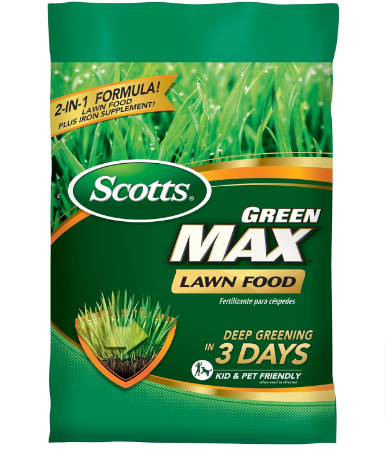
Scotts Green Max Lawn Food is a specialized lawn fertilizer designed to promote deep green color and overall grass health. This product combines essential nutrients with iron supplements to enhance the vibrancy of your lawn, making it an excellent choice for homeowners looking to achieve a lush, green appearance in their ryegrass or any grass type.
Key Features
- N-P-K Ratio: This fertilizer typically has an N-P-K ratio of 27-0-4, providing a high nitrogen content (27%) that promotes rapid growth and lush green color, with additional potassium (4%) to support overall grass health and resilience.
- Iron Supplement: The inclusion of iron enhances chlorophyll production, which contributes to a richer green color. This is particularly beneficial for lawns that may be iron-deficient, ensuring vibrant grass throughout the growing season.
- Coverage Area: A 16.67 lbs. bag covers up to 5,000 square feet, making it suitable for medium-sized lawns.
Benefits for Ryegrass
- Promotes Greener Grass: The high nitrogen content, coupled with iron, ensures that ryegrass develops a rich, deep green color quickly, making it an ideal choice for revitalizing tired or yellowing lawns.
- Supports Healthy Growth: By providing essential nutrients, Scotts Green Max helps maintain strong grass blades, improving drought resistance and overall lawn vitality.
- Easy Application: This granular fertilizer can be easily spread using a broadcast spreader, allowing for uniform coverage across the lawn.
Application Guidelines
- When to Apply: Scotts Green Max can be applied during the growing season, with early spring and early fall being ideal times to boost growth and color. Regular applications every 6-8 weeks can help maintain optimal lawn health.
- How to Apply: Use a broadcast spreader to evenly distribute the granules over the lawn. Follow the manufacturer’s recommended application rate, typically around 3.5 pounds per 1,000 square feet, to avoid over-fertilization.
Considerations
- Temperature Sensitivity: Avoid applying during extreme heat or drought conditions, as this can stress the grass and limit its recovery.
- Watering Requirements: It’s advisable to water the lawn lightly after application to help the nutrients penetrate the soil and reduce the risk of burning.
- Potential for Staining: Take care when handling and applying, as the iron can stain concrete and other surfaces if not cleaned promptly.
Scotts Green Max Lawn Food is an effective fertilizer for achieving a greener, healthier lawn, particularly beneficial for ryegrass. With its high nitrogen content and iron supplementation, this product supports rapid growth and vibrant color, making it an excellent addition to any lawn care routine. Regular use can help maintain a lush, attractive landscape throughout the growing season.
Tips for Successful Fertilization
Proper fertilization is essential for maintaining a healthy, vibrant ryegrass lawn. By following these best practices, you can maximize the benefits of fertilization and ensure optimal growth.
Test the Soil
- Why it’s Important: Conducting a soil test before fertilization helps you understand the nutrient levels and pH of your soil. This allows you to select the right fertilizer blend based on your lawn’s specific needs, preventing over-fertilization or nutrient deficiencies.
- How to Do It: Use a DIY soil test kit or send a sample to a local agricultural extension for professional analysis. Pay special attention to the levels of nitrogen, phosphorus, potassium, and pH balance.
Choose the Right Fertilizer
- Match the Nutrient Needs: Select a fertilizer that meets the nutrient requirements of ryegrass, which generally benefits from a nitrogen-rich formulation. Look for fertilizers with balanced N-P-K ratios like 16-4-8 or high-nitrogen formulas such as 27-0-4.
- Synthetic vs. Organic: Consider whether a synthetic or organic fertilizer is best for your lawn. Synthetic fertilizers offer quick results, while organic options improve soil health and structure over time.
Time the Application
- Spring and Fall: For cool-season grasses like ryegrass, the best times to fertilize are early spring (just before the grass enters its peak growing season) and fall (to encourage root development and prepare the lawn for winter).
- Avoid Summer Stress: Avoid fertilizing in the heat of summer when ryegrass is more prone to stress, as the increased nutrient load could cause more harm than good.
- Reapply as Needed: Follow the manufacturer’s recommended fertilization schedule (typically every 4-8 weeks during the growing season) for optimal results.
Apply Evenly
- Use a Spreader: To ensure even coverage, apply granular fertilizers with a broadcast or drop spreader. This will prevent over-fertilizing certain areas and under-fertilizing others, which can lead to inconsistent growth.
- Watering: Water the lawn lightly after applying granular fertilizer to help the nutrients dissolve and penetrate the soil. For liquid fertilizers, apply evenly and avoid over-saturating any areas.
Avoid Over-Fertilizing
- Why It’s Harmful: Over-fertilizing can lead to nutrient burn, excessive thatch buildup, and increased susceptibility to disease and pests. Additionally, overuse can cause harmful runoff into nearby water sources.
- How to Prevent: Always follow the recommended application rate on the fertilizer package. More fertilizer does not equal faster or better growth, and applying too much can damage your lawn.
Fertilize After Mowing
- Mowing First: Fertilize after mowing, not before, to prevent the fertilizer from getting caught in long grass blades. This allows it to reach the soil more effectively.
- Leave Grass Clippings: Consider leaving grass clippings on the lawn after mowing, as they can naturally decompose and return valuable nutrients like nitrogen to the soil.
Monitor Lawn Health
- Watch for Signs: Keep an eye on how your ryegrass responds to fertilization. Look for signs of stress such as yellowing (a sign of over-fertilization) or patchy growth (indicating uneven application or nutrient deficiency).
- Adjust Accordingly: If you notice problems, adjust the fertilization schedule or switch to a different type of fertilizer that better meets your lawn’s needs.
Consider Environmental Conditions
- Weather Considerations: Avoid fertilizing before heavy rain to prevent runoff. Similarly, applying fertilizer during a drought without proper irrigation can cause the grass to burn.
Buying Guide: Best Fertilizer for Ryegrass
When selecting the best fertilizer for your ryegrass lawn, there are several factors to consider. This buying guide will help you make an informed decision by breaking down key aspects such as nutrient needs, fertilizer types, application methods, and environmental considerations.
Understand Your Ryegrass Needs
- Cool-Season Grass: Ryegrass thrives in cooler temperatures and has peak growth in spring and fall. Fertilizers high in nitrogen are beneficial for promoting lush, green growth during these periods.
- Soil Testing: Conduct a soil test to determine your lawn’s nutrient deficiencies and pH levels. Ryegrass prefers slightly acidic to neutral soil (pH 6.0 to 7.0), and knowing your soil’s condition will help you choose the right fertilizer.
Nutrient Content (N-P-K Ratios)
- Nitrogen (N): This is the most important nutrient for ryegrass. It promotes leaf growth and a vibrant green color. Look for fertilizers with a high nitrogen content, especially during active growth seasons (e.g., 20-5-10 or 16-4-8).
- Phosphorus (P): Phosphorus supports root development, especially useful when establishing new ryegrass or after overseeding. However, many areas restrict phosphorus use due to environmental concerns, so make sure to check local regulations.
- Potassium (K): Potassium improves the overall health of ryegrass by strengthening its resistance to stress, diseases, and drought. Balanced fertilizers like 16-4-8 often contain potassium for this purpose.
Types of Fertilizers
- Synthetic Fertilizers: These are chemically manufactured and provide immediate results. They are great for giving ryegrass a quick nutrient boost and often come in precise N-P-K ratios. Examples include:
- Scotts Turf Builder Triple Action1: Provides weed control, weed prevention, and fertilization in one application.
- Scotts Green Max Lawn Food: High in nitrogen and includes iron for a quick, deep green effect.
- Organic Fertilizers: Derived from natural sources such as compost, bone meal, or fish emulsion, organic fertilizers improve soil health over time. They release nutrients slowly and are safer for the environment.
- Milorganite: A popular organic option that improves soil health while providing slow-release nitrogen.
- Liquid Fertilizers: Quick-acting and easy to apply, liquid fertilizers can be mixed with water and sprayed over the lawn. These are ideal for delivering nutrients directly to the grass blades.
- Advanced 16-4-8 Liquid Fertilizer: A balanced N-P-K liquid fertilizer suitable for all grass types, providing quick absorption.
Release Rate
- Slow-Release Fertilizers: These release nutrients gradually over time, providing a steady supply of nutrients for your ryegrass. They reduce the risk of nutrient leaching and require fewer applications. Ideal for maintaining lawn health throughout the growing season.
- Examples: Milorganite (organic slow-release) or Scotts Turf Builder.
- Fast-Release Fertilizers: These provide an immediate nutrient boost and are useful for quick greening or when addressing nutrient deficiencies. However, they may require more frequent applications and have a higher risk of burning the grass if over-applied.
Application Methods
- Granular Fertilizers: These are applied using a broadcast or drop spreader. Granular fertilizers offer more control over the distribution and can be slow-release or fast-release. They are suitable for larger lawns and provide even coverage.
- Liquid Fertilizers: Easy to apply with a sprayer, liquid fertilizers offer quick absorption by the grass. They are great for smaller lawns or when you need fast results. They may need to be applied more frequently than granular options.
Seasonal Considerations
- Spring: Fertilize ryegrass in early spring with a nitrogen-rich fertilizer to stimulate rapid growth and improve color.
- Fall: Apply a balanced or slow-release fertilizer in early fall to prepare ryegrass for winter and encourage deep root growth.
- Summer: Avoid fertilizing ryegrass during the hot summer months unless absolutely necessary. Over-fertilizing during heat can cause stress and burn the grass.
Environmental Impact
- Organic vs. Synthetic: Organic fertilizers are environmentally friendly and improve soil structure over time. Synthetic fertilizers can be more efficient and provide quicker results but may lead to runoff and pollution if not applied correctly.
- Phosphorus Restrictions: Some areas have regulations on phosphorus use due to its potential to cause water pollution. Choose a phosphorus-free fertilizer if your soil test shows adequate levels, or if local regulations restrict phosphorus use.
Size and Coverage
- Bag Size: Determine the size of the fertilizer bag based on the square footage of your lawn. Many products provide coverage information on the packaging (e.g., 5,000 sq. ft. or 12,000 sq. ft.).
- Application Rate: Follow the manufacturer’s recommended application rate to avoid over-fertilization and ensure even nutrient distribution.
Budget
- Cost vs. Coverage: Consider the cost per square foot when evaluating fertilizers. While organic options may be more expensive, they can offer long-term soil health benefits.
- Frequency of Application: Slow-release fertilizers may cost more upfront but require fewer applications, saving money in the long run.
Conclusion
Choosing the best fertilizer for ryegrass involves understanding the specific nutrient needs of your lawn, selecting the right N-P-K ratio, and considering factors such as fertilizer type, release rate, and application method. Whether you opt for a synthetic, organic, granular, or liquid fertilizer, it’s important to tailor your selection to the season, soil conditions, and lawn size. Products like Scotts Turf Builder Triple Action1 and Milorganite provide specialized solutions for various needs, from weed control to soil health improvement. By following proper fertilization techniques and timing, you can ensure a lush, healthy ryegrass lawn that thrives year-round.
FAQ:
1. How often should I fertilize my ryegrass lawn?
Ryegrass typically benefits from fertilization 2 to 4 times per year, especially during its active growing seasons in spring and fall. You can fertilize every 4-8 weeks during these periods, depending on the product and your lawn’s needs. Always follow the manufacturer’s recommended schedule for optimal results.
2. What is the best N-P-K ratio for ryegrass?
Ryegrass generally benefits from high-nitrogen fertilizers to support green growth. A common recommended N-P-K ratio is 16-4-8, but other high-nitrogen formulas like 27-0-4 are also effective. The exact ratio depends on your soil’s current nutrient levels, so a soil test can help you choose the best option.
3. Can I use organic fertilizer for ryegrass?
Yes, organic fertilizers like Milorganite are great for ryegrass. They release nutrients slowly and improve the soil structure over time, promoting long-term lawn health. Organic options are also safer for the environment and reduce the risk of burning the grass.
4. Is liquid or granular fertilizer better for ryegrass?
Both liquid and granular fertilizers can work well for ryegrass. Granular fertilizers are great for slow-release, long-term feeding, while liquid fertilizers provide quick results and are easy to apply. If you want fast greening, liquid fertilizers like Advanced 16-4-8 are a good choice, whereas granular options like Scotts Green Max are ideal for steady growth.
5. Should I fertilize ryegrass in the summer?
It’s best to avoid fertilizing ryegrass in the heat of summer. Ryegrass is a cool-season grass, and fertilizing during high temperatures can stress the lawn. Instead, focus on fertilization in early spring and fall when the grass is actively growing.
6. How much fertilizer do I need for my lawn?
The amount of fertilizer you need depends on your lawn’s size and the product’s coverage capacity. For example, a 16.67 lbs. bag of Scotts Green Max Lawn Food covers 5,000 square feet. Always follow the recommended application rate on the product label to ensure proper coverage and avoid over-fertilization.
7. Can I apply fertilizer and overseed my ryegrass at the same time?
It’s best to avoid applying fertilizers with pre-emergent weed control products (such as Scotts Turf Builder Triple Action1) when overseeding, as the pre-emergent ingredients can prevent seed germination. However, you can use starter fertilizers with phosphorus to support new seed growth.
8. How do I prevent fertilizer burn on ryegrass?
To prevent fertilizer burn, follow the recommended application rates and water your lawn after applying fertilizer. Over-fertilization or applying in dry, hot conditions increases the risk of burning the grass. Slow-release fertilizers are less likely to cause burns than fast-release options.
9. Do I need to water my lawn after applying fertilizer?
Yes, watering your lawn after applying fertilizer helps nutrients absorb into the soil and prevents the granules from sitting on top of the grass. For liquid fertilizers, a light watering helps the nutrients penetrate more effectively.
10. Can I apply fertilizer before rain?
Light rain can help fertilize your lawn by washing the nutrients into the soil. However, avoid fertilizing before heavy rain, as it can cause runoff and waste the fertilizer. Check the weather forecast before applying to ensure optimal conditions.
References
- Scotts Lawn Care Products
Scotts Turf Builder and Green Max Lawn Food product information were sourced from the official Scotts website, which provides detailed descriptions of each fertilizer, including application rates, N-P-K ratios, and benefits for various grass types.
Scotts Official Website - Milorganite Fertilizer
Information on Milorganite’s organic slow-release fertilizer, its benefits for lawn care, and how it improves soil health over time was obtained from the official Milorganite website.
Milorganite Official Website - Simple Lawn Solutions
Details on the Advanced 16-4-8 Balanced NPK Liquid Fertilizer, including its application methods and suitability for ryegrass, were gathered from the manufacturer’s product page.
Simple Lawn Solutions Website - University of California Agriculture and Natural Resources
General guidelines for fertilizing cool-season grasses like ryegrass, including tips on fertilization timing, nutrient requirements, and best practices for lawn care.
UC ANR – Lawn Fertilization Guide - The Lawn Institute
Best practices for applying fertilizers to cool-season grasses, including tips for using organic versus synthetic fertilizers, were reviewed from the Lawn Institute’s resources on proper lawn care and maintenance.
The Lawn Institute
